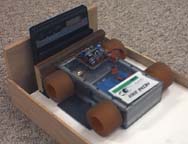| Urethane Tires A form was constructed to mold four 2 1/4" diameter tires. The mold was capable of handling up to 2 1/2 " wide tires. Using the urethane mixture from the Portland Area Robotics Society web page (Tap Plastics part A and B Urethane RTV and Polytech part C) four tires were made for Runt and eight tires were made for Sticky.
Sticky, without the extra lead, weighed in at 3 pounds 10 ounces. Clean, old silicone coated tires could push 3 pounds 7.2 ounces. New, molded urethane tires pushed 7 pounds 10 ounces, but one tire was spinning off of the ground and the other three motors were stalled.
 Smaller, more powerful 7.2 volt motors were obtained from Lynxmotion for Sticky which dropped the weight to 3 pounds 5.6 ounces. With old clean silicone coated tires, Sticky could push 3 pounds 12 ounces. Molded urethane tires increased Sticky's weight to 3 pounds 10.2 ounces and achieved a push of 9 pounds 12 ounces, or 268% ORW (Of Robots Weight). Since I like silicone, a set of tires was molded using Polytech Platsil 71-20. With these tires, Sticky pushed 8 pounds 12 ounces, or 238% ORW. Smaller, more powerful 7.2 volt motors were obtained from Lynxmotion for Sticky which dropped the weight to 3 pounds 5.6 ounces. With old clean silicone coated tires, Sticky could push 3 pounds 12 ounces. Molded urethane tires increased Sticky's weight to 3 pounds 10.2 ounces and achieved a push of 9 pounds 12 ounces, or 268% ORW (Of Robots Weight). Since I like silicone, a set of tires was molded using Polytech Platsil 71-20. With these tires, Sticky pushed 8 pounds 12 ounces, or 238% ORW.
Exhume weighed in at 2 pounds 5.2 ounces and could push 4 pounds 8 ounces with clean, molded urethane tires. There was much jumping around indicating that more work must be done with controlling the power. |